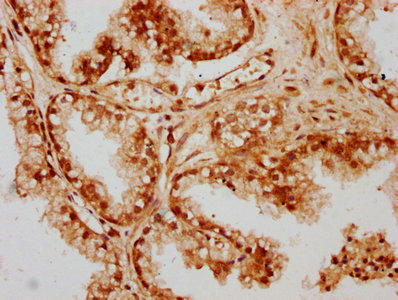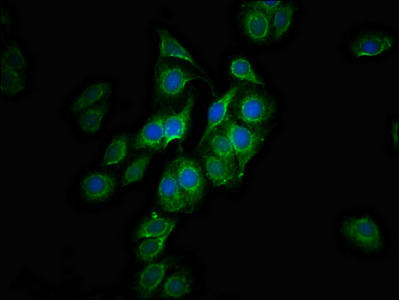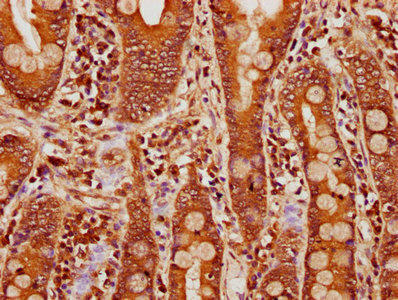Description
| Antibody Name: | CPTP Antibody (PACO60993) |
| Antibody SKU: | PACO60993 |
| Size: | 50ug |
| Host Species: | Rabbit |
| Tested Applications: | ELISA, IHC, IF |
| Recommended Dilutions: | ELISA:1:2000-1:10000, IHC:1:200-1:500, IF:1:50-1:200 |
| Species Reactivity: | Human |
| Immunogen: | Recombinant Human Ceramide-1-phosphate transfer protein (1-214AA) |
| Form: | Liquid |
| Storage Buffer: | Preservative: 0.03% Proclin 300 Constituents: 50% Glycerol, 0.01M PBS, pH 7.4 |
| Purification Method: | >95%, Protein G purified |
| Clonality: | Polyclonal |
| Isotype: | IgG |
| Conjugate: | Non-conjugated |
 | IHC image of PACO60993 diluted at 1:300 and staining in paraffin-embedded human prostate cancer performed on a Leica BondTM system. After dewaxing and hydration, antigen retrieval was mediated by high pressure in a citrate buffer (pH 6.0). Section was blocked with 10% normal goat serum 30min at RT. Then primary antibody (1% BSA) was incubated at 4°C overnight. The primary is detected by a biotinylated secondary antibody and visualized using an HRP conjugated SP system. |
 | Immunofluorescence staining of HepG2 cells with PACO60993 at 1:100, counter-stained with DAPI. The cells were fixed in 4% formaldehyde, permeabilized using 0.2% Triton X-100 and blocked in 10% normal Goat Serum. The cells were then incubated with the antibody overnight at 4°C. The secondary antibody was Alexa Fluor 488-congugated AffiniPure Goat Anti-Rabbit IgG(H+L). |
 | IHC image of PACO60993 diluted at 1:300 and staining in paraffin-embedded human small intestine tissue performed on a Leica BondTM system. After dewaxing and hydration, antigen retrieval was mediated by high pressure in a citrate buffer (pH 6.0). Section was blocked with 10% normal goat serum 30min at RT. Then primary antibody (1% BSA) was incubated at 4°C overnight. The primary is detected by a biotinylated secondary antibody and visualized using an HRP conjugated SP system. |
| Background: | Mediates the intracellular transfer of ceramide-1-phosphate between organelle membranes and the cell membrane. Required for normal structure of the Golgi stacks. Can bind phosphoceramides with a variety of aliphatic chains, but has a preference for lipids with saturated C16:0 or monounsaturated C18:1 aliphatic chains, and is inefficient with phosphoceramides containing lignoceryl (C24:0). Plays a role in the regulation of the cellular levels of ceramide-1-phosphate, and thereby contributes to the regulation of phospholipase PLA2G4A activity and the release of arachidonic acid, Has no activity with galactosylceramide, lactosylceramide, sphingomyelin, phosphatidylcholine, phosphatidic acid, and ceramide. |
| Synonyms: | Ceramide-1-phosphate transfer protein (CPTP) (Glycolipid transfer protein domain-containing protein 1) (GLTP domain-containing protein 1), CPTP, GLTPD1 |
| UniProt Protein Function: | Mediates the intracellular transfer of ceramide-1-phosphate (C1P) between organelle membranes and the cell membrane. Required for normal structure of the Golgi stacks. Can bind phosphoceramides with a variety of aliphatic chains, but has a preference for lipids with saturated C16:0 or monounsaturated C18:1 aliphatic chains, and is inefficient with phosphoceramides containing lignoceryl (C24:0). Plays a role in the regulation of the cellular levels of ceramide-1-phosphate, and thereby contributes to the regulation of phospholipase PLA2G4A activity and the release of arachidonic acid. Has no activity with galactosylceramide, lactosylceramide, sphingomyelin, phosphatidylcholine, phosphatidic acid and ceramide. C1P transfer is stimulated by phosphatidylserine in C1P source vesicles (PubMed:28011644). Regulates autophagy, inflammasome mediated IL1B and IL18 processing, and pyroptosis, but not apoptosis (PubMed:29164996). |
| UniProt Protein Details: | |
| NCBI Summary: | |
| UniProt Code: | Q5TA50 |
| NCBI GenInfo Identifier: | 71274150 |
| NCBI Gene ID: | 80772 |
| NCBI Accession: | NP_001025056.1 |
| UniProt Secondary Accession: | Q5TA50,Q4G0E6, Q7L5A4 |
| UniProt Related Accession: | Q5TA50 |
| Molecular Weight: | 24,365 Da |
| NCBI Full Name: | ceramide-1-phosphate transfer protein |
| NCBI Synonym Full Names: | ceramide-1-phosphate transfer protein |
| NCBI Official Symbol: | CPTP |
| NCBI Official Synonym Symbols: | GLTPD1 |
| NCBI Protein Information: | ceramide-1-phosphate transfer protein |
| UniProt Protein Name: | Ceramide-1-phosphate transfer protein |
| UniProt Synonym Protein Names: | Glycolipid transfer protein domain-containing protein 1Curated; GLTP domain-containing protein 11 PublicationManual assertion based on opinion iniRef.8"Non-vesicular trafficking by a ceramide-1-phosphate transfer protein regulates eicosanoids."Simanshu D.K., Kamlekar R.K., Wijesinghe D.S., Zou X., Zhai X., Mishra S.K., Molotkovsky J.G., Malinina L., Hinchcliffe E.H., Chalfant C.E., Brown R.E., Patel D.J.Nature 500:463-467(2013) [PubMed] [Europe PMC] [Abstract]Cited for: X-RAY CRYSTALLOGRAPHY (1.9 ANGSTROMS) IN COMPLEXES WITH CERAMIDE-1-PHOSPHATE, FUNCTION, SUBCELLULAR LOCATION, LIPID-BINDING, MUTAGENESIS OF PHE-42; LEU-43; PHE-50; ILE-53; ASP-56; LYS-60; ARG-97; ARG-106; ARG-110; ARG-113; TRP-117; LEU-118; TYR-149 AND VAL-158, TISSUE SPECIFICITY. |
| Protein Family: | Ceramide-1-phosphate transfer protein |
| UniProt Gene Name: | CPTP |
| UniProt Entry Name: |






